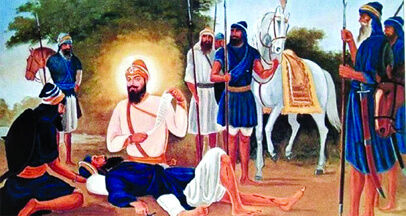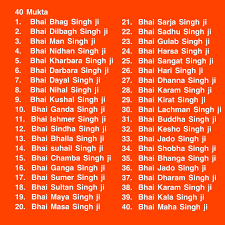The saga of the Chali Mukte (Forty Liberated Ones) represents one of the most inspiring chapters in Sikh history. These forty Sikhs, who had once left Guru Gobind Singh Ji during a challenging battle, later sought forgiveness and returned to fight bravely alongside him at the Battle of Muktsar in 1705 .They valiantly laid down their lives against the Mughal forces, earning the Guru’s blessings and ultimate liberation.

Historical Context
The Siege of Anandpur Sahib
In 1704, Anandpur Sahib faced a prolonged siege by the combined forces of the Mughal Empire and local Hill Rajas. For eight grueling months, approximately 10,000 Sikhs under the leadership of Sri Guru Gobind Singh Ji withstood the onslaught of nearly one million enemy soldiers. The conditions within Anandpur grew increasingly dire as the siege continued, with provisions completely exhausted to the point where the Khalsa survived on leaves and tree bark.
The Bedava (Disclaimer)
Under these extreme circumstances, forty Sikhs from the Majha region, led by Bhai Mahan Singh, decided they could no longer endure the hardships. They approached Guru Gobind Singh Ji, renouncing their status as his Sikhs and expressing their desire to return home. The Guru asked them to formalize their decision by signing a document known as the "Bedava" (disclaimer), stating they were no longer his Sikhs. After signing this document, they were permitted to leave Anandpur Sahib.
This act of leniency by Guru Gobind Singh Ji was extraordinary, as deserters in warfare have historically faced severe punishment. Instead, the Guru allowed them to depart freely, demonstrating his understanding of human frailty and respect for individual choice.
The Transformation
Mai Bhago's Intervention
The story of the Chali Mukte would be incomplete without acknowledging the pivotal role of Mai Bhago (also known as Mata Bhag Kaur), a brave and devout Sikh woman from the village of Jhabal in the Majha region. Upon learning that men from her area had abandoned their Guru in his time of need, Mai Bhago was deeply disturbed.
With remarkable courage and conviction, she confronted these forty Sikhs, reminding them of their spiritual duty and the principles of the Khalsa. Her powerful words ignited a profound change in their hearts, awakening them to the moral failure of their desertion and their enduring responsibility toward their Guru.
The Return to Duty
Inspired by Mai Bhago's faith and stirring words, the forty deserters experienced deep remorse for their actions. Their decision to return to Guru Gobind Singh Ji represented not merely a physical journey but a profound spiritual transformation—a return to their core principles and a recommitment to the path of the Khalsa.
Led by Mai Bhago herself, who donned warrior's attire and took up arms, these forty repentant Sikhs set out to find their Guru and offer their lives in his service.
The Battle of Muktsar
Strategic Confrontation
On December 29, 1705, the forty Sikhs, along with Mai Bhago, intercepted the Mughal forces pursuing Guru Gobind Singh Ji near a pool called Khidrana (later renamed Muktsar or "Pool of Liberation"). Understanding the strategic importance of the water source in the arid landscape, they positioned themselves between the approaching imperial army and the Guru.
Despite being vastly outnumbered—forty Sikhs against approximately 10,000 Mughal soldiers—they chose to make their stand at this location, determined to protect their Guru at any cost.
The Ultimate Sacrifice
The battle that ensued demonstrated extraordinary bravery and tactical acumen. The forty Sikhs, along with Mai Bhago, used the marshy terrain to their advantage, slowing down the enemy cavalry and employing guerrilla tactics to compensate for their smaller numbers. Guru Gobind Singh Ji supported them from a nearby hill with a shower of arrows.
The "Chali Mukte" led by Mai Bhago inflicted such damage on the 10,000-strong Mughal force that they had no option but to retreat. Their heroic sacrifice enabled the Guru to hold the valuable reservoir water, forcing the exhausted enemy troops to retreat due to thirst and the unexpected fierce resistance.
By the day's end, all forty of the Majha warriors had fallen in battle, having redeemed themselves through the ultimate sacrifice. This battle is recorded in British War History as a remarkable example of how a small force defeated a much larger army through courage and tactical brilliance.
Legacy and Spiritual Significance
The Final Blessing
After the battle, Guru Gobind Singh Ji walked among the fallen, searching for any survivors. He found Bhai Mahan Singh still clinging to life, along with the wounded but surviving Mai Bhago. In one of the most moving moments in Sikh history, the Guru took the dying Bhai Mahan Singh in his arms.
With his last breath, Bhai Mahan Singh made a final request—that the Guru destroy the Bedava they had signed at Anandpur Sahib and forgive their earlier desertion. Guru Gobind Singh Ji immediately tore up the document into pieces, symbolically reinstating them as his Sikhs and blessing them with "mukti" (spiritual liberation).
It was at this moment that the forty deserters-turned-martyrs received the honorific title "Chali Mukte" (Forty Liberated Ones), signifying their spiritual liberation through sacrifice and devotion.
Achieving Mukti
In Sikh philosophy, "mukti" extends beyond mere release from the cycle of birth and death; it represents spiritual awakening and freedom from worldly attachments and sins. Through their selfless sacrifice at Muktsar, the Chali Mukte achieved this liberation, transcending their earlier desertion and reaffirming their loyalty to their Guru.
Their transformation from deserters to martyrs exemplifies the Sikh belief in the possibility of redemption through sincere repentance and righteous action. Their story teaches that while human beings may falter, true devotion and courage can lead to spiritual elevation.
Commemoration and Remembrance

Daily Remembrance in Ardas
The Chali Mukte are remembered daily in the Sikh Ardas (prayer), where their sacrifice is invoked as an inspiration for all Sikhs. This regular commemoration ensures that their example of courage and redemption remains alive in the collective consciousness of the Sikh community.
Maghi Festival
The martyrdom of the Chali Mukte is commemorated annually during the Maghi festival, held at Muktsar, the site of their last stand. This festival marks an important moment in the Sikh calendar, where thousands of devotees gather to pay homage to these warriors. The day is filled with prayers, hymns, and community meals (langar), reflecting on the virtues of sacrifice, courage, and the eternal guidance of the Guru.
Sacred Sites at Muktsar
The battlefield where the Chali Mukte laid down their lives has become a sacred pilgrimage site, drawing devotees from around the world. Five significant Gurdwaras now stand at Muktsar to commemorate different aspects of the battle:
Gurdwara Tambu Sahib
Gurdwara Shahidganj Sahib
Sri Darbar Sahib
Gurudwara Tibbi Sahib
Gurdwara Rakabsar Sahib
These sites serve as tangible connections to the past and sources of spiritual inspiration for pilgrims.
Enduring Teachings
The story of the Chali Mukte offers profound lessons that continue to resonate within the Sikh community and beyond:
Moral Courage: The journey of the Chali Mukte demonstrates that true bravery extends beyond physical courage on the battlefield to the moral courage required to acknowledge one's mistakes and seek redemption.
Transformation: Their story illustrates the human capacity for profound change, showing how individuals can transform from fear to strength and from guilt to redemption.
Humility and Selfless Service: The willingness of the Chali Mukte to sacrifice everything, including their lives, without seeking recognition exemplifies the Sikh virtue of selfless service (seva).
Forgiveness: Guru Gobind Singh Ji's compassionate forgiveness of the deserters highlights the importance of mercy and understanding in spiritual leadership.
Cultural and Spiritual Significance
The tale of the Chali Mukte is rich in spiritual and cultural significance, offering profound lessons that resonate deeply within the Sikh community and beyond:
Teachings of Bravery and Repentance: The story portrays bravery not just in the physical sense on the battlefield, but also the moral courage required for repentance.
Transformative Power of Loyalty to Faith: Their loyalty to Guru Gobind Singh Ji, rekindled through their act of returning, underscores the concept that true faith is not stagnant but an evolving relationship with one's beliefs.
Ethos of Resisting Oppression: The Chali Mukte reflect the Sikh principle of standing against oppression and upholding justice, even under dire circumstances.
Mercy of the Gurus: The merciful nature of Guru Gobind Singh Ji, who welcomed back the deserters without hesitation, highlights a fundamental teaching within Sikhism about the boundless grace of the Guru.
Conclusion
The story of the Chali Mukte is more than just history—it is a lesson in faith, redemption, and resilience. These forty warriors, who once left Guru Gobind Singh Ji, later returned with devotion, sacrificing their lives at the Battle of Muktsar. Their journey teaches that true courage lies not just in fighting battles but in recognizing one’s mistakes and standing for righteousness. Their legacy continues to inspire Sikhs to live with faith, integrity, and commitment, no matter the challenges they face.
Their legacy lives on as an example to the long lasting bond between Guru and Sikh, and the profound spiritual transformation that can occur when one chooses the path of devotion and sacrifice over self-preservation.
Note - We have made every effort to ensure the accuracy and reliability of the information provided. However, this content is intended for informational purposes only and reflects historical and cultural perspectives. DVN does not assume responsibility for any disputes or actions that may arise from the use of this content. If you believe any information is incorrect or misleading, please contact us .